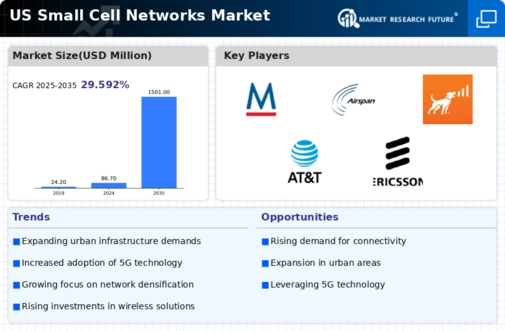The US Small Cell Networks Market has emerged as a critical component in the telecommunications landscape, driven by the increasing demand for high-speed wireless connectivity and the growing need to support the proliferation of mobile devices. As urban areas become denser and consumer expectations for seamless connectivity rise, small cell technology provides a practical solution by enhancing network capacity and coverage. This creates a dynamic competitive environment where various telecom equipment manufacturers, service providers, and technology innovators are vying for market share.
The competitive landscape is characterized by rapid technological advancements, aggressive marketing strategies, and strategic partnerships that shape the market's future trajectory. Understanding the strengths, weaknesses, and collaborative efforts of major players within this ecosystem is essential for analyzing the competitive dynamics shaping the US Small Cell Networks Market.Mavenir has established itself as a significant player in the US Small Cell Networks Market by leveraging its strengths in innovative solutions and agile technology development. The company focuses on transforming the way network services are deployed and managed, enabling operators to optimize their existing infrastructure with cost-effective small cell implementations.
Mavenir's approach emphasizes cloud-native technology, which enhances the scalability and efficiency of mobile networks, appealing to telecom operators seeking to upgrade their capabilities without extensive investments in traditional hardware. Moreover, Mavenir has cultivated strategic partnerships with various service providers, enhancing its presence in the US market and allowing it to offer tailored solutions that meet the specific requirements of operators in different regions.
This adaptability and focus on innovation position Mavenir favorably within the competitive landscape.Verizon Communications holds a prominent position in the US Small Cell Networks Market as a leading telecommunications provider with a vast infrastructure and a comprehensive array of services. The company offers a suite of small cell solutions designed to enhance network performance and address the challenges of urban congestion. Verizon's extensive network investments and strategic initiatives enable it to deliver high-quality connectivity to consumers and businesses alike, leveraging cutting-edge technology to ensure seamless experiences.
Additionally, Verizon is actively pursuing mergers and acquisitions to bolster its capabilities and expand its market share, which places it in a strong competitive position within the sector. The company’s commitment to innovation extends to its product offerings, which include various small cell configurations and deployment strategies tailored to urban environments, thus allowing it to adapt quickly to changing market demands. This continual enhancement of service offerings cements Verizon's status as a key player in the US Small Cell Networks Market.
















Leave a Comment